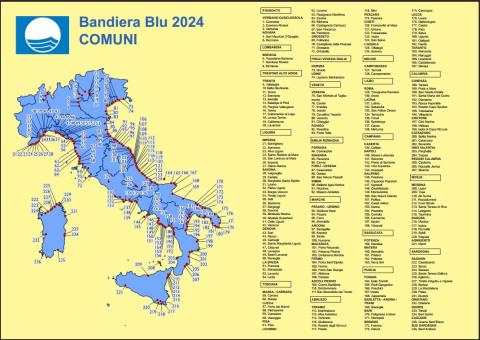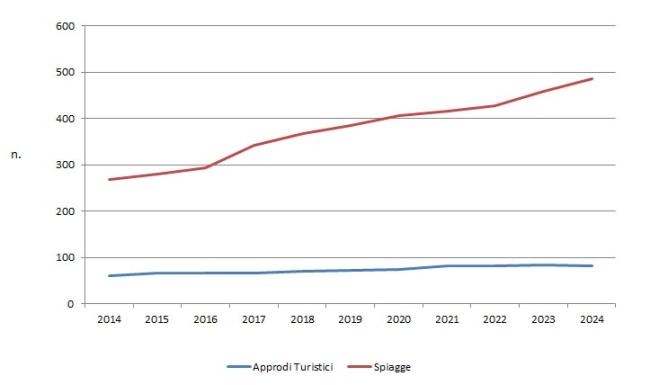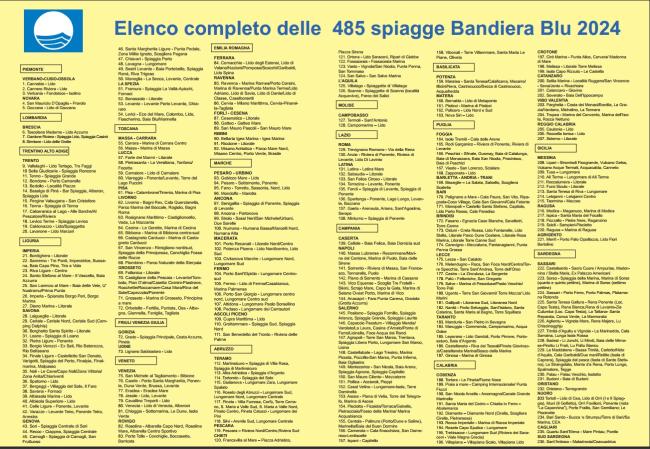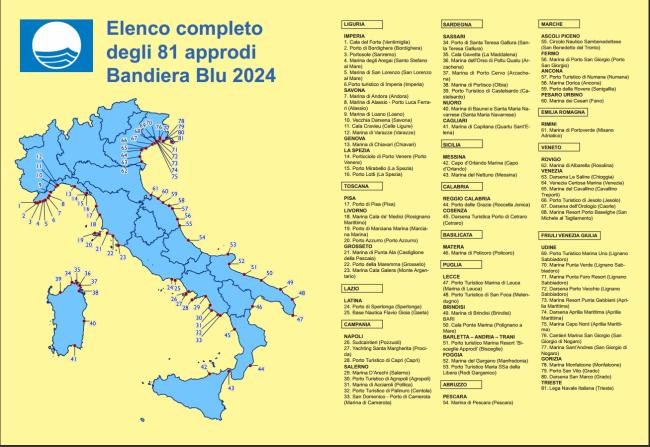Panel 1
Giovanni Finocchiaro, Silvia Iaccarino
The Blue Flag remains one of the most prestigious international environmental labels for beaches and tourist marinas. In 2024, Italy confirms itself as one of the nations with the highest number of awards, totaling 485 Blue Flags for beaches and 81 for tourist marinas, demonstrating a continuous commitment to sustainability in coastal and lake tourist destinations.
The indicator shows the number of Blue Flags awarded to various Italian regions for beaches and tourist marinas.
The Blue Flag Program, an International Eco-label for certifying the environmental quality of coastal areas, has gained worldwide recognition among both tourists and tourism operators as a reliable environmental certification associated with sustainable tourism in marine and lake destinations.
The Blue Flag is awarded to coastal tourist locations that meet criteria related to sustainable territorial management.
The Blue Flag Program was established in 1987, the European Year of the Environment. Blue Flags are awarded annually in 49 countries (initially only European, now also non-European) by the FEE (Foundation for Environmental Education), recognized by UNESCO as the global leader in environmental education and sustainable development education.
The program is supported by and involves two United Nations agencies—UNEP (United Nations Environment Programme) and UNWTO (World Tourism Organization)—with which the FEE has signed a global partnership agreement.
The program criteria are periodically updated to encourage participating local administrations to address and improve environmental management challenges over time, ensuring careful environmental protection.
To monitor the spread of sustainable territorial management in coastal locations, based on policy decisions focused on environmental care and protection.
The indicator has no regulatory objectives, as it is a voluntary certification tool.
Panel 2
www.blueflag.global;
http://www.bandierablu.org
A new sub-indicator could be created for beaches by calculating the number of Blue Flags per kilometer of coastline.
Data quality assessment
Foundation for environmental education
http://www.bandierablu.org/ www.blueflag.global;
National, Regional
2014-2024
Indicator assessment
The indicator records the total number of beaches and tourist marinas per region, as provided by the FEE.
- A beach can be awarded a Blue Flag if it is officially designated as a bathing area at the national (or international) level, with at least one water quality sampling point.
- The name and boundaries of the beach must match official national designations.
- A tourist marina can be awarded a Blue Flag if it has piers and docks for recreational boats.
- It may be part of a larger port with other activities, provided the marina is clearly separated from other port operations.
- The marina may be located in marine or inland waters.
Both must have the necessary services and meet Blue Flag criteria, fulfilling all mandatory requirements and, ideally, as many guideline requirements as possible.
The requirements are related to:
- Environmental education and training
- Environmental management
- Services and safety
- Water quality
Between 2023 and 2024, the number of Blue Flag beaches in Italy increased, showing a 5.9% growth compared to the previous year. However, the number of certified tourist marinas recorded a slight decrease (Figure 1).
The current status of Blue Flag-certified beaches and marinas in Italy is good, with a geographical distribution covering the entire national territory:
- Liguria remains the leader with 34 certified beaches.
- Sardinia shows significant growth in the number of Blue Flag beaches, reflecting a widespread and ongoing commitment by local administrations to sustainable resource management.
From 2014 to 2024, Italy recorded a significant increase in the number of Blue Flag-certified beaches and marinas:
- The number of beaches increased by approximately 80%, from 269 in 2014 to 485 in 2024 (Figure 1).
- This indicates continuous improvements in environmental management at tourist locations and a growing adoption of sustainable practices by local administrations.
- The number of tourist marinas followed a similar growth trend, increasing by about 33%, from 61 in 2014 to 81 in 2024 (Figure 1).
- Although Italy does not lead in Europe in the number of certified marinas, this growth still reflects greater attention to sustainability in both port and tourism sectors (Table 1).
The significant increase in certifications over the past decade highlights the success of environmental policies and the willingness of tourist destinations to continuously improve water quality, services, and environmental management. This trend not only enhances the tourism value of certified destinations, but also helps strengthen Italy's reputation as a sustainable tourist destination.
Data
Table 1: Distribuzione internazionale etichette "Bandiera blu" (2024)
Elaborazione ISPRA su dati http://www.blueflag.global/
Tabella 2: Distribuzione regionale dei comuni con con etichetta "bandiera blu"
Elaborazione ISPRA su dati http://www.bandierablu.org/
Tabella 3: Distribuzione regionale degli approdi turistici italiani con etichetta "bandiera blu"
Elaborazione ISPRA su dati http://www.bandierablu.org/





In 2024, Italy obtained 485 Blue Flags for beaches and 81 for tourist marinas, solidifying its position among the most environmentally responsible countries globally for the sustainable management of coastal and port areas (Table 1, Figures 3 and 4).
At the regional level:
For tourist marinas:
At the international level, Italy ranks among the top countries for Blue Flag awards, placing fourth globally in 2024, behind Spain, Greece, and Turkey (Table 1).
This international comparison highlights the strategic value of the Blue Flag program as a key element in enhancing the competitiveness of Italian tourist destinations, aligning them with international sustainability standards.
Ultimately, the rising number of Blue Flag-certified beaches and marinas in Italy demonstrates not only a positive national trend, but also Italy's ability to compete with other major Mediterranean and global tourist destinations.